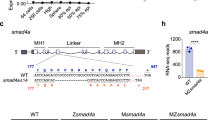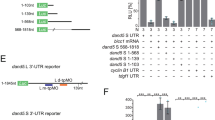Abstract
Signalling by Decapentaplegic (Dpp), a member of the TGFβ superfamily of signalling molecules, controls many aspects of Drosophila development by activating and repressing target genes. Several essential components of the Dpp signalling pathway have been identified, including the Dpp receptors Punt and Thick veins (Tkv) as well as the cytoplasmic mediators Mad and Medea. For target genes to be activated, Dpp signalling must suppress transcription of a repressor encoded by the brinker (brk) gene. Here we show that Schnurri (Shn), a large zinc-finger protein, is essential for Dpp-mediated repression of brk transcription; in contrast, Shn is not required for target-gene activation. Thus, the Dpp signalling pathway bifurcates, downstream of the signal-mediating SMAD proteins, into a Shn-dependent pathway leading to brk repression and a Shn-independent pathway leading to gene activation. The existence of several Shn-like proteins in vertebrates and the observation that Brk functions in BMP signalling in Xenopus indicates that a similar regulatory cascade may be conserved in higher organisms.
This is a preview of subscription content, access via your institution
Access options
Subscribe to this journal
Receive 12 print issues and online access
$209.00 per year
only $17.42 per issue
Buy this article
- Purchase on Springer Link
- Instant access to full article PDF
Prices may be subject to local taxes which are calculated during checkout





Similar content being viewed by others
References
Raftery, L. A. & Sutherland, D. J. TGF-β family signal transduction in Drosophila development: from Mad to Smads. Dev. Biol. 210, 251–268 ( 1999).
Massagué, J. TGF-β signal transduction. Annu. Rev. Biochem. 67, 753–791 (1998).
Massagué, J. & Wotton, D. Transcriptional control by the TGF-β/Smad signaling system. EMBO J. 19, 1745–1754 (2000).
Campbell, G. & Tomlinson, A. Transducing the Dpp morphogen gradient in the wing of Drosophila: Regulation of Dpp targets by brinker. Cell 96, 553– 562 (1999).
Jaźwińska, A., Kirov, N., Wieschaus, E., Roth, S. & Rushlow, C. The Drosophila gene brinker reveals a novel mechanism of Dpp target gene regulation. Cell 96, 563–573 (1999).
Minami, M., Kinoshita, N., Kamoshida, Y., Tanimoto, H. & Tabata, T. brinker is a target of Dpp in Drosophila that negatively regulates Dpp-dependent genes. Nature 398, 242–246 (1999).
Jaźwińska, A., Rushlow, C. & Roth, S. The role of brinker in mediating the graded response to Dpp in early Drosophila embryos. Development 126, 3323–3334 (1999).
Arora, K. et al. The Drosophila schnurri gene acts in the Dpp/TGFβ signalling pathway and encodes a transcription factor homologous to the human MBP family. Cell 81, 781– 790 (1995).
Grieder, N. C., Nellen, D., Burke, R., Basler, K. & Affolter, M. schnurri is required for Drosophila Dpp signalling and encodes a zinc finger protein similar to the mammalian transcription factor PRDII-BFI. Cell 81, 791– 800 (1995).
Staehling-Hampton, K., Laughon, A.S. & Hoffmann, F.M. A Drosophila protein related to the human zinc finger transcription factor PRDII/MBPI/HIV-EP1 is required for dpp signalling. Development 121, 3393– 3403 (1995).
Burke, R. & Basler, K. Dpp receptors are autonomously required for cell proliferation in the entire developing Drosophila wing. Development 122, 2261–2269 (1996).
Bienz, M. Induction of the endoderm in Drosophila. Sem. Cell Dev. Biol. 7, 113–119 (1996).
Tsuneizumi, K. et al. Daughters against dpp modulates dpp organizing activity in Drosophila wing development. Nature 389, 627–631 (1997).
Nellen, D., Burke, R., Struhl, G. & Basler, K. Direct and long-range action of a DPP morphogen gradient. Cell 85, 357–368 (1996).
Lecuit, T. et al. Two distinct mechanisms for long-range patterning by decapentaplegic in the Drosophila wing. Nature 381, 387–393 (1996).
Kim, J. et al. Integration of positional signals and regulation of wing formation and identity by Drosophila vestigal gene. Nature 382, 133–138.
Kim, J., Hohnson, K., Chen, H. J., Carroll, S. & Laughon, A. Drosophila Mad binds to DNA and directly mediates activation of vestigial by Decapentaplegic. Nature 388, 304–308.
Udagawa, Y. et al. Schnurri interacts with Mad in a Dpp-dependent manner. Genes to Cell 5, 359–370 (2000).
Certel, K., Hudson, A., Carroll, S. B. & Johnson, W. A. Restricted patterning of vestigal expression in Drosophila wing imaginal discs requires synergistic activation by both Mad and the Drifter POU domain transcription factor. Development 127, 3173–3183 (2000).
Fan, C. M. & Maniatis, T. A DNA-binding protein containing two widely separated zinc finger motifs that recognize the same DNA sequence . Genes Dev. 4, 29–42 (1990).
Mitchelmore, C., Traboni, C. & Cortese, R. Isolation of two cDNAs encoding zinc finger proteins which bind to the a1-antitrypsin promoter and to the major histocompatibility complex class I enhancer. Nucleic Acids Res. 19, 141–147 (1990).
Baldwin, A. S. Jr, LeClair, K. P., Singh, H. & Sharp, P. A. A large protein containing zinc finger domains bind to related sequence elements in the enhancer of the class I major histocompatibility complex and kappa immunoglobulin genes. Mol. Cell Biol. 10, 1406–1414 (1990).
Brand, A. & Perrimon, N. Targeted gene expression as a means of altering cell fates and generating dominant phenotypes. Development 118, 401–415 (1993).
Grieder, N. C. Involvement of the zinc finger protein encoded by the schnurri gene of Drosophila melanogaster in the signal transduction pathway of Dpp. PhD Thesis, Univ. Basel, Switzerland (1997).
Ruberte, E., Marty, T., Nellen, D., Affolter, M. & Basler, K. An absolute requirement for both the type II and type I receptors, Punt and thick veins, for Dpp signaling in vivo. Cell 80, 890–898 (1995).
Martin-Bermudo, M. D., Dunin-Borkowski, O. M. & Brown, N. H. Specificity of PS integrin function during embryogenesis resides in the alpha subunit extracellular domain. EMBO J. 16, 4184–4193 (1997).
Tautz, D. & Pfeifle, C. A non-radioactive in situ hybridization method for the localization of specific RNAs in Drosophila embryos reveals a translational control of the segmentation gene hunchback . Chromosoma 98, 81–85 (1989).
Acknowledgements
We thank R. Schuh, S. Cohen and N. Patel for antibodies, and S. Roth, C. Rushlow, A. Tomlinson, N. Brown and S. B. Carroll for flies and cDNAs. We also thank N. C. Grieder for the UAS-shn strains and C. Bazinet for comments on the manuscript. This work was supported by the Swiss National Science Foundation and by the Kantons of Basel-Stadt, Basel-Land and Zürich. During the course of this work, M.A. was a START fellow of the Swiss National Science Foundation.
Author information
Authors and Affiliations
Corresponding author
Additional information
Correspondence and requests for materials should be addressed to M. A.
Rights and permissions
About this article
Cite this article
Marty, T., Müller, B., Basler, K. et al. Schnurri mediates Dpp-dependent repression of brinker transcription . Nat Cell Biol 2, 745–749 (2000). https://doi.org/10.1038/35036383
Received:
Revised:
Accepted:
Published:
Issue Date:
DOI: https://doi.org/10.1038/35036383
This article is cited by
-
Understanding morphogenetic growth control — lessons from flies
Nature Reviews Molecular Cell Biology (2011)
-
Spatial discontinuity of Optomotor-blind expression in the Drosophila wing imaginal disc disrupts epithelial architecture and promotes cell sorting
BMC Developmental Biology (2010)
-
A conserved activation element in BMP signaling during Drosophila development
Nature Structural & Molecular Biology (2010)
-
The Decapentaplegic morphogen gradient: from pattern formation to growth regulation
Nature Reviews Genetics (2007)
-
Murine Schnurri-2 is required for positive selection of thymocytes
Nature Immunology (2001)



